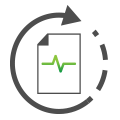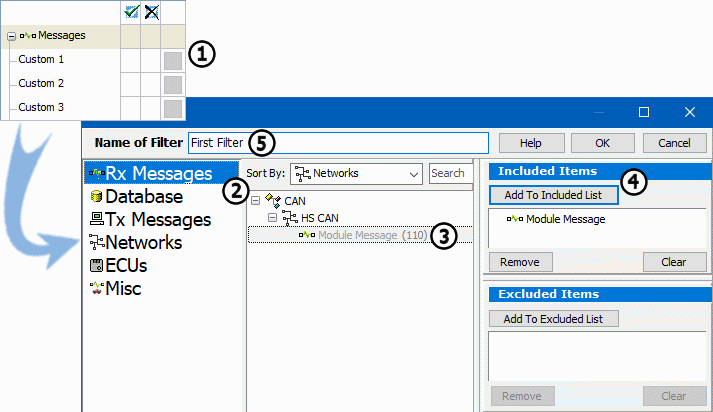 Messages View Custom Filters
Messages View Custom Filters
 Messages View Custom Filters
Messages View Custom Filters
Custom filters are filters than can include user defined groups of Messages, ECUs, and Networks. This group can then be included or excluded in the Filter Bar. Messages view supports up to 99 custom filters.
Custom filters are located under the Messages category in the Filter Bar. By default, they are named Custom 1, Custom 2, and so on. Additional custom filters added by clicking the Add button at the top of the Filter Bar. To delete a custom filter, right click on it and select Remove Message Filter.
As with the other standard filters, clicking in the first column to the right of the filter name activates the filter ( ). Clicking in the
second column to the right reverses the filter (
). Clicking in the
second column to the right reverses the filter ( ).
).
Edit the filter by clicking the small gray box in the third column to the right of the custom filter title (Figure 1: ). Clicking the box opens
the Setup Filter dialog shown in Figure 1.
). Clicking the box opens
the Setup Filter dialog shown in Figure 1.
In the Setup Filter dialog, give the filter a custom name by typing in the Name of Filter field (Figure 1: ). The name entered replaces
the default name in the Filter Bar when returning to Messages view. Renaming a filter is especially useful when working with several filters.
). The name entered replaces
the default name in the Filter Bar when returning to Messages view. Renaming a filter is especially useful when working with several filters.
Next, define the filter. The first step is to select a data source located just below the Name of Filter heading (Figure 1: ). They include: Rx
Messages, Database, Tx Messages, Networks, ECUs, and Misc. Details about each data source can be found below in Table 1. When selecting a data source from the list,
available items (messages, signals, etc.) will be shown in the central window in a tree (Figure 1:
). They include: Rx
Messages, Database, Tx Messages, Networks, ECUs, and Misc. Details about each data source can be found below in Table 1. When selecting a data source from the list,
available items (messages, signals, etc.) will be shown in the central window in a tree (Figure 1: ).
).
To add an item to your filter, simply select it from the tree and press the Add to Included List button
(Figure 1: ) or the Add to Excluded List button. A filter can contain both included and excluded items.
(Double clicking on an item in the tree will automatically add it to the Included Items list.) All items added to a filter will appear in either the Included Items or Excluded Items list.
If an item is accidentally added, remove it by selecting the item and pressing the Remove button. Clear the entire filter by pressing the Clear button.
) or the Add to Excluded List button. A filter can contain both included and excluded items.
(Double clicking on an item in the tree will automatically add it to the Included Items list.) All items added to a filter will appear in either the Included Items or Excluded Items list.
If an item is accidentally added, remove it by selecting the item and pressing the Remove button. Clear the entire filter by pressing the Clear button.
When the filter is finished, press the OK button to automatically return to the Messages view. All that is left is to click in the green checkmark column and activate the filter!

| Data Source | Description | ||||||||||||||||
| Rx Messages, Database, Tx Messages | A list of all messages and signals defined for each network in the Messages Editor or Database. | ||||||||||||||||
| Networks | A list of Networks. | ||||||||||||||||
| ECUs | A list of ECUs in each network. | ||||||||||||||||
| Misc | List of Message properties includes:
|